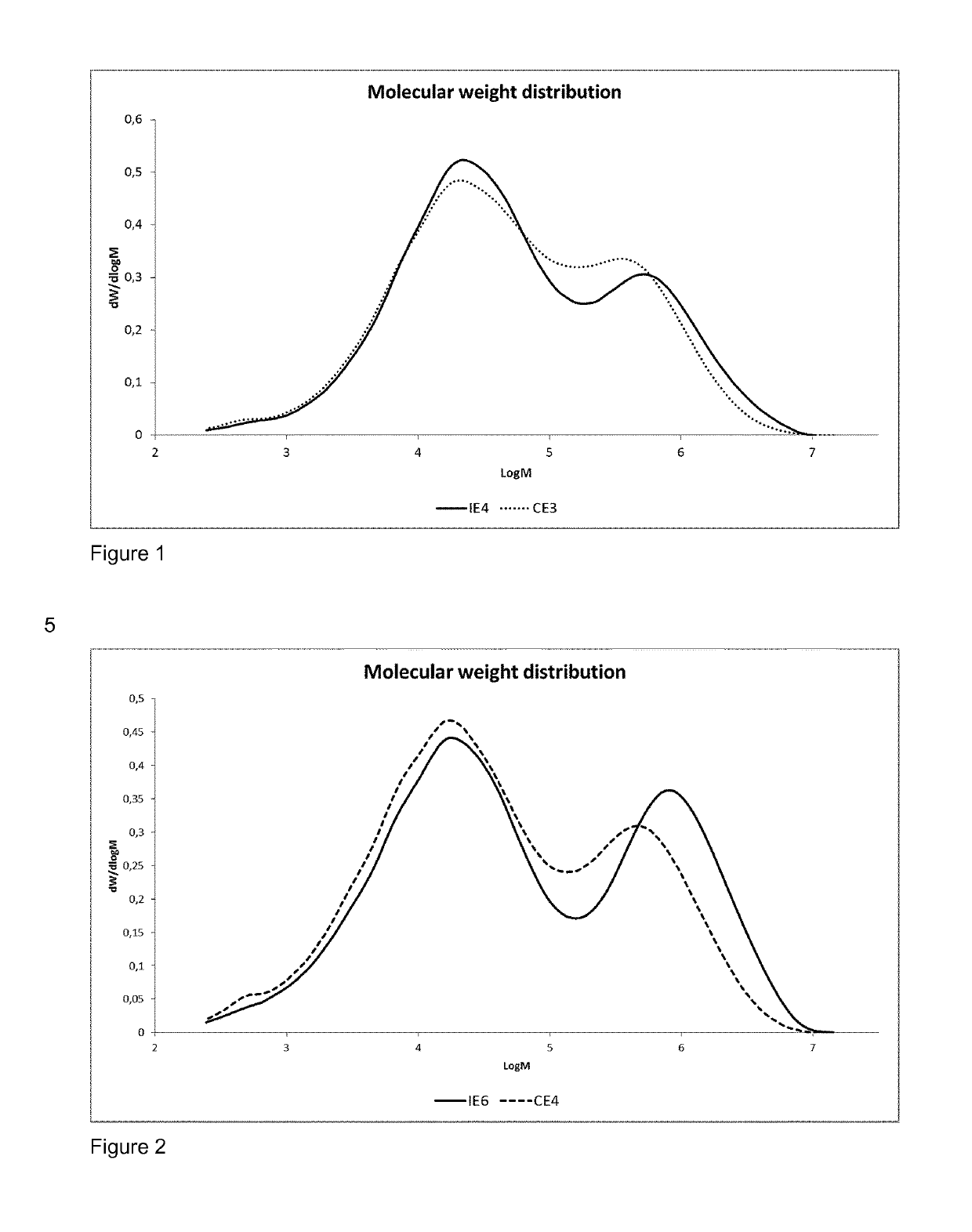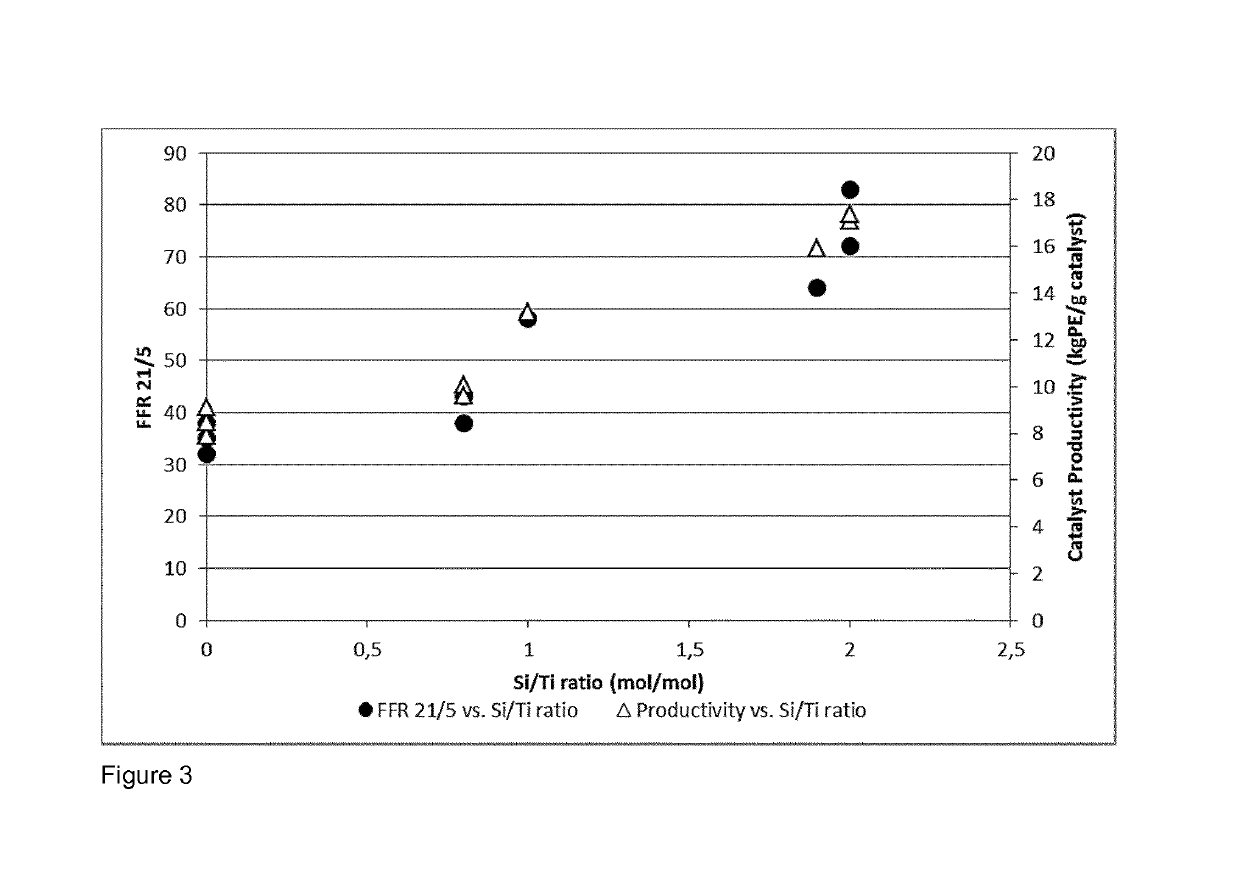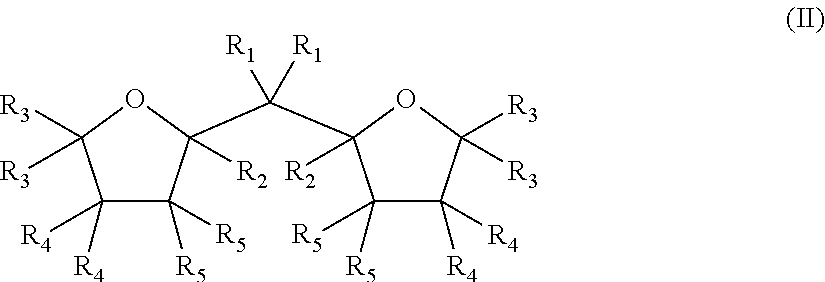Process for producing polyethylene
a polyethylene and polyethylene technology, applied in the field of olefinic monomer production, can solve the problems of high hsub>2/sub>/csub>2 /sub>molar ratio, low ethylene concentration/partial pressure, and often produced polymers at the expense of catalyst productivity, etc., to achieve broad molecular weight distribution, high molecular weight, and the effect of increasing the molecular weight of the polymer produced in the second stag
- Summary
- Abstract
- Description
- Claims
- Application Information
AI Technical Summary
Benefits of technology
Problems solved by technology
Method used
Image
Examples
reference example 1
Preparation of Solid Catalyst Component 1
Mg Compound Preparation:
[0195]Toluene (87 kg) was added into the 100 liter reactor. Then Bomag A, provided by Chemtura, (45.5 kg, 20 wt % butyloctyl magnesium in heptane) was also added to the reactor. Then 2-ethyl-1-hexanol (161 kg, 99.8 wt %) was introduced into the reactor at a flow rate of 24-40 kg / h. The molar ratio between BOMAG-A and 2-ethyl-1-hexanol was 1:1.83.
Preparation of Solid Catalyst Component:
[0196]Silica (330 kg of calcined silica, Sylopol® 2100) and pentane (0.12 kg / kg carrier) were charged into a catalyst preparation reactor. Then EADC (ethylaluminium dichloride, 2.66 mol / kg silica) was added into the reactor at a temperature below 40° C. during two hours and mixing was continued for one hour. The temperature during mixing was 40-50° C. Then the magnesium compound prepared as described above was added (2.56 mol Mg / kg silica) at 50° C. during two hours and mixing was continued at 40-50° C. for one hour. Then 0.84 kg pentane / ...
reference example 2
Preparation of Solid Catalyst Component 2
Raw Materials
[0198]The standard 10 and 25 wt % TEA (triethyl aluminium) solutions in heptane were prepared by dilution of 100% TEA-S from Chemtura.
[0199]MgCl2*3EtOH carriers were received from GRACE
[0200]2,2-Di(2-tetrahydrofuryl)propane (DTHFP) was supplied by TCI EUROPE N.V. as a mixture (1:1) of diastereomers (D,L-(rac)-DTHFP and meso-DTHFP.
[0201]TiCl4 was supplied by Aldrich (Metallic impurities99.9%).
A. Pre-Treated Support Material Preparation:
[0202]In an inert atmosphere glove box (2, H2O): A dry 100 mL, 4-neck round-bottom flask equipped with two rubber septa, a thermometer, and mechanical stirrer was charged with 0.38 g of DTHFP (DTHFP / Mg=0.1 mol / mol) dissolved in 30 mL of heptane and 5 g (20 mmol of Mg) of granular 21 μm (d50) MgCl2*3EtOH carrier. The flask was removed from the glove-box, a nitrogen inlet and outlet were fixed. The flask was placed in a cooling bath and stirred for approximately 10 min at 250 rpm. A precooled 25 wt % ...
##ventive example 6 (
Inventive Example 6 (IE6) and Comparative Example 4 (CE4)
[0209]Ethylene hexene copolymer was produced in a continuous multistage process comprising two slurry-loop reactors of size 150 and 350 liters and one gas phase reactor. In addition a prepolymerisation step was used in examples IE6 and CE4. Temperature in the prepolymerisation step was 70° C., 950° C. in the loop reactors, and 85° C. in the gas phase reactor. Propane was used as the reaction medium in the loop reactors. The same catalyst component prepared according to the reference example 2 and triethylaluminium (TEA) as cocatalyst were used at an Al / Ti molar ratio of 2. The sum of all cocatalyst feeds to the loop reactor includes the optional prepolymerisation step, 1st loop reactor, and 2nd loop reactor. In the inventive example IE6 dimethyldimethoxy silane (DMDS) was as the external additive (external donor), supplied by TCI EUROPE N.V., used as received.
[0210]In comparative example CE4 no external donor was used.
[0211]Th...
PUM
| Property | Measurement | Unit |
|---|---|---|
| polydispersity index PDI | aaaaa | aaaaa |
| polydispersity index PDI | aaaaa | aaaaa |
| density | aaaaa | aaaaa |
Abstract
Description
Claims
Application Information
 Login to View More
Login to View More - R&D
- Intellectual Property
- Life Sciences
- Materials
- Tech Scout
- Unparalleled Data Quality
- Higher Quality Content
- 60% Fewer Hallucinations
Browse by: Latest US Patents, China's latest patents, Technical Efficacy Thesaurus, Application Domain, Technology Topic, Popular Technical Reports.
© 2025 PatSnap. All rights reserved.Legal|Privacy policy|Modern Slavery Act Transparency Statement|Sitemap|About US| Contact US: help@patsnap.com



